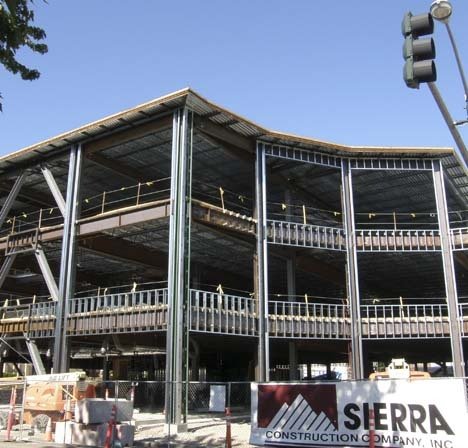Meager foot traffic and vacant storefronts in downtown Auburn were on the minds of residents, the Auburn Area Chamber of Commerce and the Auburn Downtown Association in 2001 when they produced a blueprint for downtown redevelopment called the Auburn Downtown Plan.
That effort was followed up in 2005 by a document called Economic Development Strategies that identified key areas throughout the city in need of redevelopment.
On Monday, Mayor Pete Lewis, addressing the Auburn Area Chamber of Commerce’s Partnership Luncheon at Emerald Downs, explained the meaning of all that planning, especially in the downtown.
“This is a city transforming itself to recapture livability downtown,” Lewis said.
He noted the following progress:
• The parking garage and Auburn Regional Medical Center Oncology Center one block north of City Hall. Construction of the 45,000-square-foot medical office building includes a four-level parking garage with 310 stalls that the hospital will share with the City of Auburn. The $12 million project calls for a first-floor oncology center complete with a linear accelerator. The contractor BNB Builders expects to complete work in August.
• Auburn Professional Plaza, JLO Washington Enterprises’ 3-story, $6.5 million medical and professional office building east of City Hall where the old Tavern Row once stood. The City Hall will lease all of the second floor and part of the third for a City Hall annex. The ground floor will be devoted to retail and restaurant space. A KeyBank branch will anchor the project on the east end. The building is on target for completion in November.
• The most ambitious project is yet to come — Spencer Alpert’s $240 million “Auburn Junction.” Located in downtown Auburn between the Sound Transit Station, Auburn’s City Hall, Safeway and one block south of Auburn Regional Medical Center, the Junction is proposed as a new “urban village” – a green, mixed use, urban-style, commercial and residential dominated project offering ground-floor retail and restaurant facilities and incorporating open spaces.
Alpert, president of Alpert International, said the multi-phased project would create more than 1 million square feet of new development, generate more $200 million in revenue to the city during the next 30 years, and transform the largely vacant, under-used area into a regional destination that supports and breathes new life into downtown Auburn.
Alpert tipped his hat to what is already happening in the downtown.
“One of the things to keep in mind is that the $240 million (Auburn Junction) project will be a major economic engine for the whole region, but it’s a to-be-built project,” Alpert said. “At the same time, it makes it a whole lot easier to talk about what’s going to happen when the evidence is in the ground as to what’s already occurred. Real infrastructure funding, real buildings coming out of the ground, that’s the future of this city and this region.”
City officials are hoping to tap federal and state funds to fund major parts of the ambitious makover downtown and elsewhere, as follows:
• The LIFT — Local Infrastructure Financing Tool championed by 47th District Rep. Pat Sullivan and passed this last legislative session — allows communities to designate a “revenue development area” where private companies could settle or expand, leading to jobs and more tax revenues. Cities like Auburn could then use some of the new sales tax revenues the development generates to finance bonds to pay for utilities, roads, and other improvements.
For Auburn it would be worth $250,000 per year for 25 years or $6.5 million, enough to bond $6 million dollars for downtown revitalization. The City will host a public forum in September to talk about the use of the money for downtown redevelopment and what infrastructure it will help fix. The grant requires local matching funds.
• A $3 million grant from the Economic Development Administration (EDA) for building the Promenade on South Division Street, a key component of the Auburn Junction project. This grant also requires a local match. Lewis said the City would use the state and federal grants, each requiring a local match, to satisfy the other without any committment of local dollars. The City is in the process of submitting its final application to the EDA.
“With the LIFT bill and the EDA grant, the $240 million Auburn Junction project is moving from the concept stage into action,” Lewis said.
Work will begin in April on another key project, this one outside the downtown, the $13 million, 22,000-square-foot Community Center and the 8,000- square foot Activities Center at Les Gove Park. A new pedestrian trail will link the project to the downtown. City officials say taxpayer dollars will not be involved because the City has been able to take advantage of federal government tax credits and Community Development Block Grant dollars to finance the entire project.


